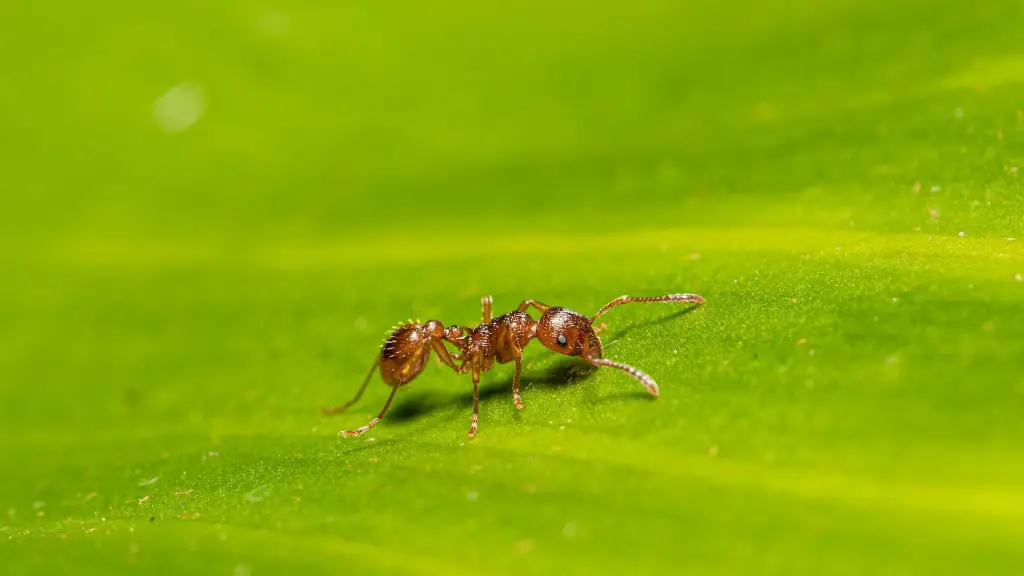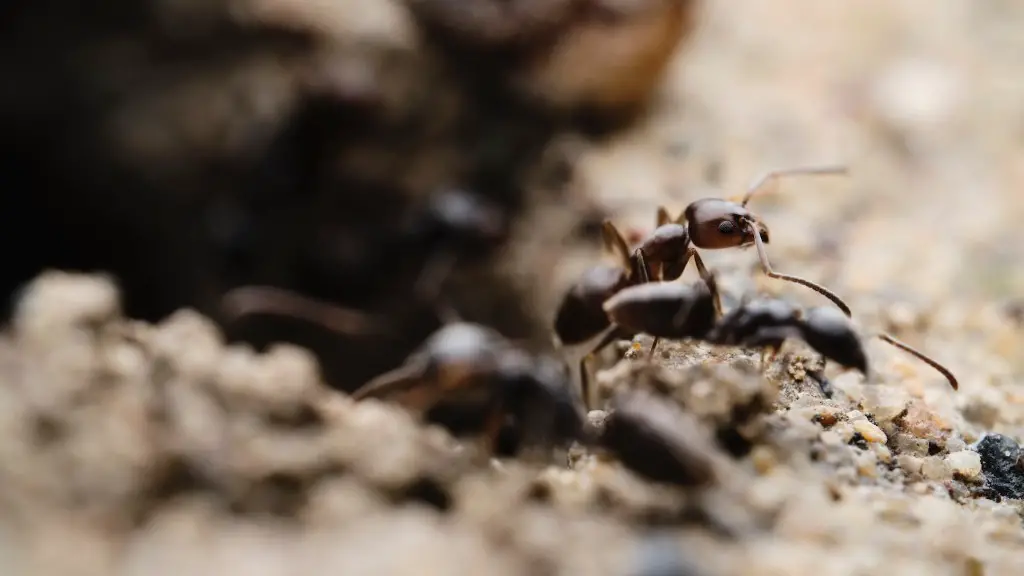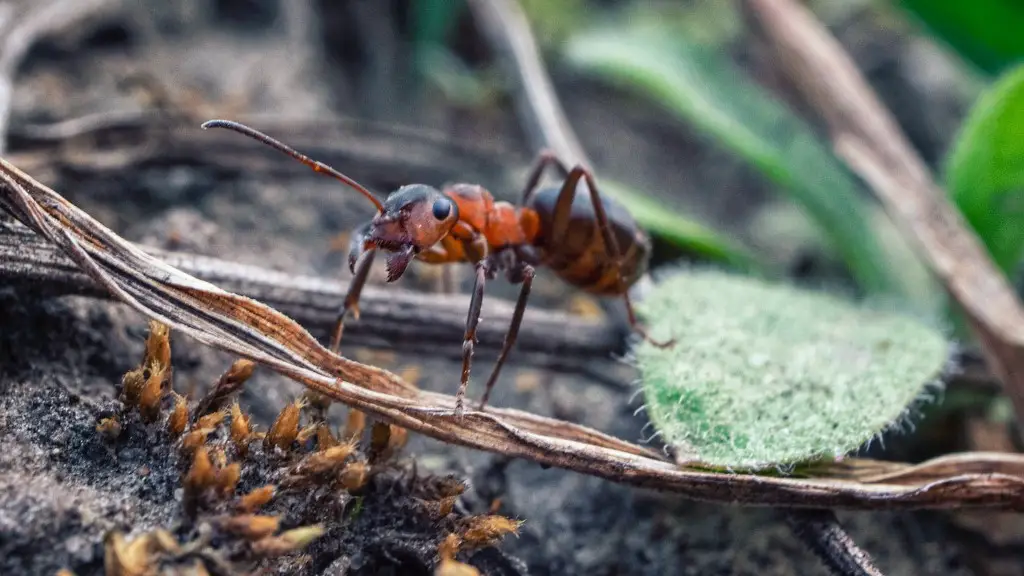What Are Army Ants?
Army ants are predatory ants species from the family Dorylinae. They are native to tropical and subtropical regions, and may be found in moist climates throughout Central and South America, sub-Saharan Africa, India, Sri Lanka, and Southeast Asia. Their scientific name is Formicidae, and they are also known as legionnaires because of their large colonies. The army ants are typically identified by their large numbers, their aggressive nature, and their nomadic way of life.
Army ants have a very distinct type of social structure, and their colonies can range in size from a few hundred to a few hundred thousand. They are also terrestrial and opportunistic hunters, and are known for their habit of crossing large distances in search of food. They build temporary nests as needed and forage for prey as a swarm. Their “raids” have earned them their name – they swarm a given area and consume anything in their way.
What Do Army Ants Eat?
Army ants are mainly carnivorous and prefer insect prey but they will also feed on other live or dead arthropods, such as centipedes, spiders, and other insects. They may also consume small vertebrates, such as mice, lizards, and frogs. Some species of army ants have been recorded preying on eggs and young of other species of ants, such as the weaver ant. Army ants also feed on scavenged carcasses of other animals.
Army ants do not feed on human flesh. Although they can cause some discomfort and bites, their mouthparts are incapable of piercing human skin and therefore they feed on smaller animals and other insects.
Behavioral Patterns of Army Ants
Army ants are known for their aggressive and unpredictable behavior. They travel in large groups with hundreds of ants, often forming a “column” of moving ants on the ground, and use their powerful mandibles to attack and feast on prey. The ants bite and grapple with the prey, and drag it back to the nest to be shared among the colony members.
Army ants have an interesting and unique swarming behavior. During their “raid”, they move in a column until they locate a food source. Then, they form a ‘bivouac’ or nest – a living, writhing mass of ants that clump together and form a shelter for the organisms within. Recent studies suggest that these bivouacs serve as an efficient defense against predators, as the clumped ants form a dense, impenetrable mass.
However, army ants aren’t just aggressive. They also communicate to coordinate their activities and communicate with the colony. They use chemical signals, such as pheromones, and physical signals, such as vibrational signals, to communicate.
How Do Army Ants Reproduce?
Army ants generally reproduce through asexual reproduction, as males are rare and many species lack queens and other reproductive forms. The process generally involves two stages. The first stage is when a female ant lays eggs in a “brood pouch”. This pouch is filled with nutrients and is carried by the female ant. The eggs become larvae, and then pupae, after they are fed and tended by the colony.
The second stage is when the pupae reach maturity and emerge as adults. As soon as they emerge, they begin to forage in a swarm, and the cycle continues and new species of army ants are formed.
Do Army Ants Pose any Threat?
Army ants are not dangerous to humans, however, they can cause some discomfort, such as stings, bites and irritation. They can also damage plants and crops, as well as infest homes, yards, and gardens. They are also known to displace other animals, including other species of ants and small animals.
In some instances, army ants have been known to attack and eat small mammals and birds, however, these instances are rare. While large colonies of army ants can cause some destruction, individual ants and small colonies of ants do not pose a real threat to humans.
How Can We Protect Ourselves from Army Ants?
There are several things that you can do to protect yourself from army ants. The most important thing is to make sure that you keep your property clean and free of any sources of food and water. Additionally, you should try to reduce any potential areas of nesting – piles of wood or dirt, leaves, etc. Additionally, one can use a pest control company or the services of an exterminator to get rid of any army ants that may have infested their home or property.
Finally, it is important to keep in mind that army ants are not aggressive towards humans and that they only hunt and attack other weaker creatures to survive. Most of the time, they will simply ignore humans, so as long as you avoid areas that are known to have a high population of army ants, you should have no issues.
Identifying Army Ants
Army ants can be identified by their dark bodies and yellow bands on their abdomens. They also have powerful mandibles, large eyes, and bulbous heads. The size of the ants can range from a few millimeters to an inch in length, depending on the species. Additionally, army ants have a distinctive movement and behavior that sets them apart from other ants.
Other signs of an army ant infestation include large numbers of ants roaming the area, bitter odors which are produced by the ants, and temporary nests which are formed with the help of living ants. Additionally, the presence of strong vibrations could also indicate an infestation.
Managing Armies Ants
The best way to manage and prevent an army ant infestation is to keep your property clean and free of any source of food or water. Clean out any trash cans, remove any stagnant water and keep food properly stored. Additionally, you should also make sure that your property is well-lit and that there are no gaps or cracks in the walls which could provide a safe haven for the ants.
It’s also a good idea to use bait traps to lure them away from your property. Additionally, one can also use a pesticide or an insecticide to help control an army ant infestation. If all else fails, one should consider calling a pest control company to help with the management and/or eliminate of an army ant infestation.
Do Army Ants Eat Humans?
In short, army ants do not eat human flesh, as they are purely carnivorous and are incapable of piercing human skin. Army ants are known to feed on live or dead arthropods, such as centipedes, spiders, and other insects, as well as some small vertebrates, such as mice, lizards, and frogs. Some species of army ants also feed on eggs and young of other species, and scavenged carcasses of other animals.
Conclusion
While army ants can cause some discomfort and bites, human flesh is not their natural source of food. They are mainly carnivorous and prefer insect prey but can also feed on other live or dead arthropods, such as centipedes, spiders, and other insects, as well as some small vertebrates, such as mice, lizards, and frogs. To protect ourselves from army ants, we can keep our property clean and free of any sources of food and water and reduce any potential areas of nesting. Additionally, one can use a pest control company or the services of an exterminator to get rid of any army ants that may have infested our home or property.


